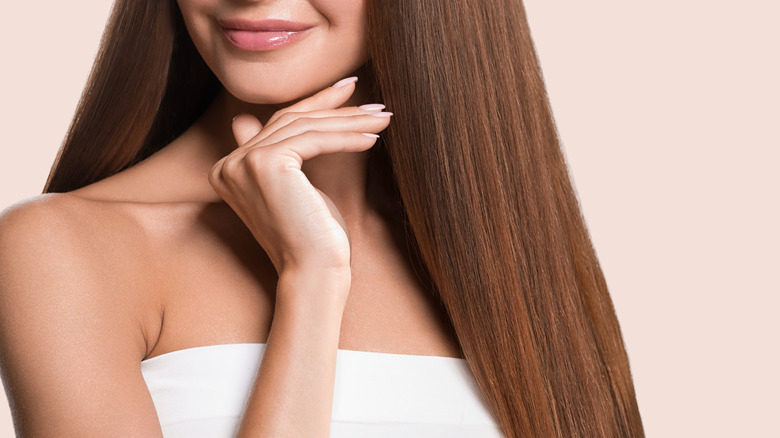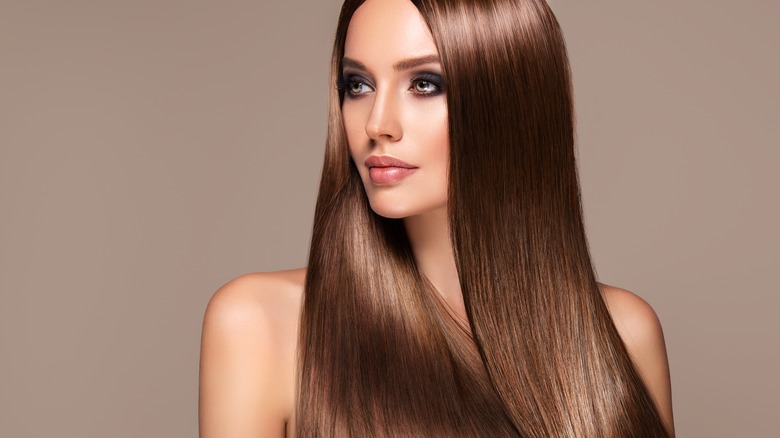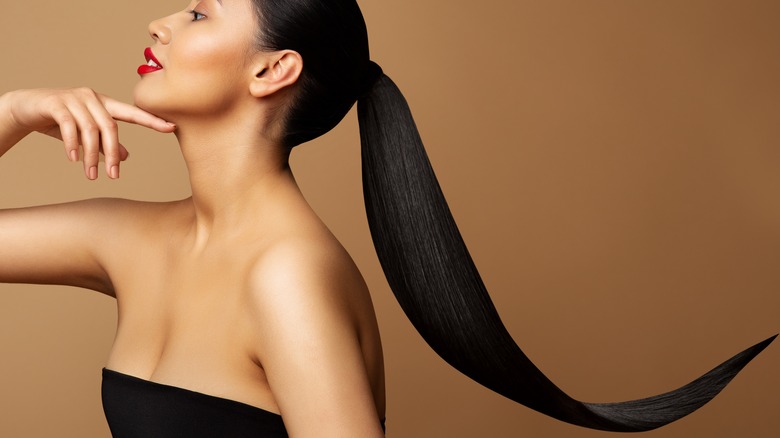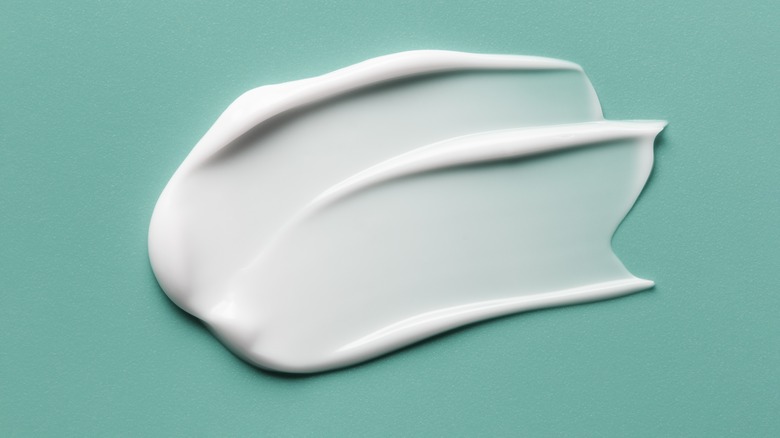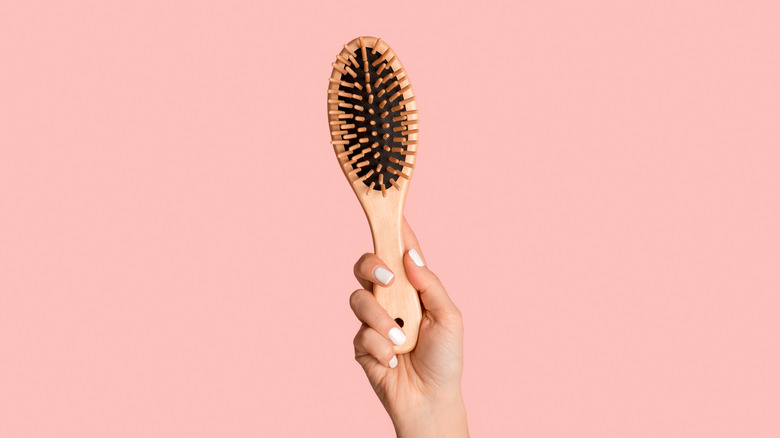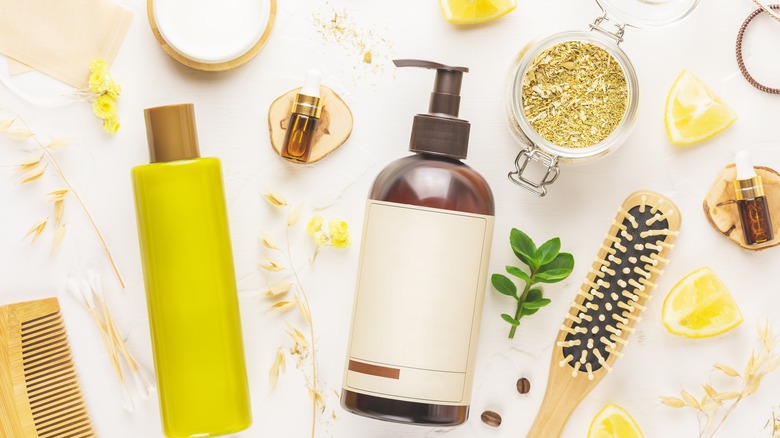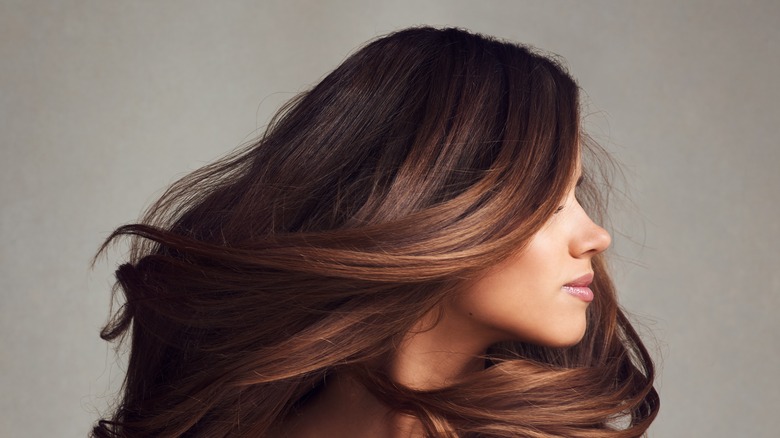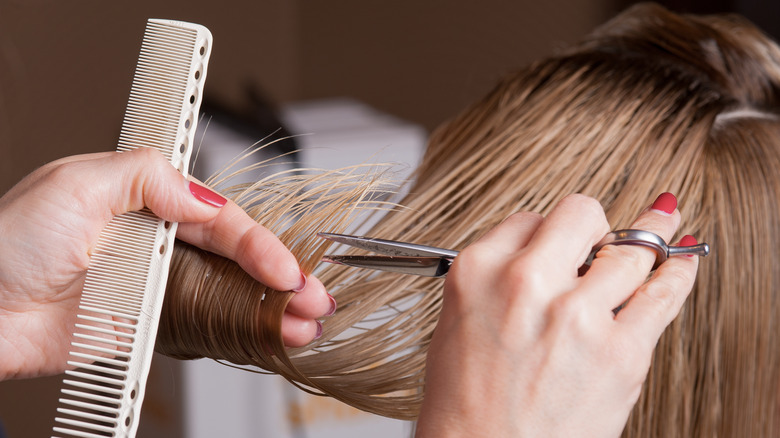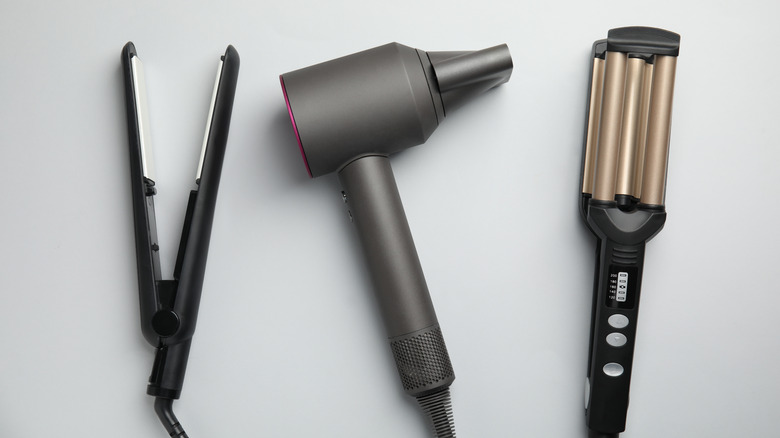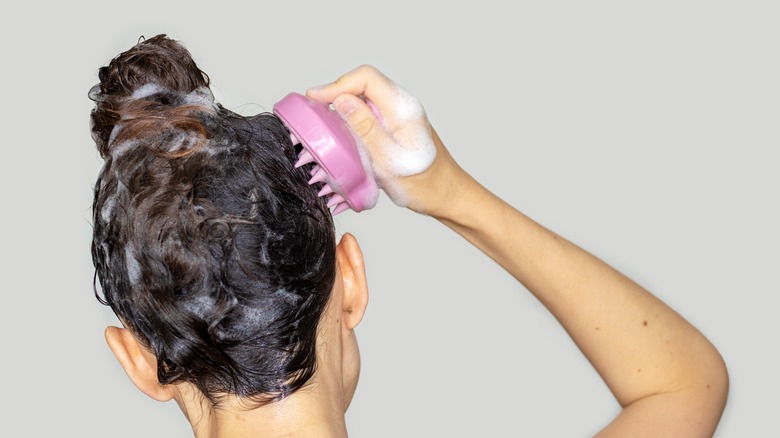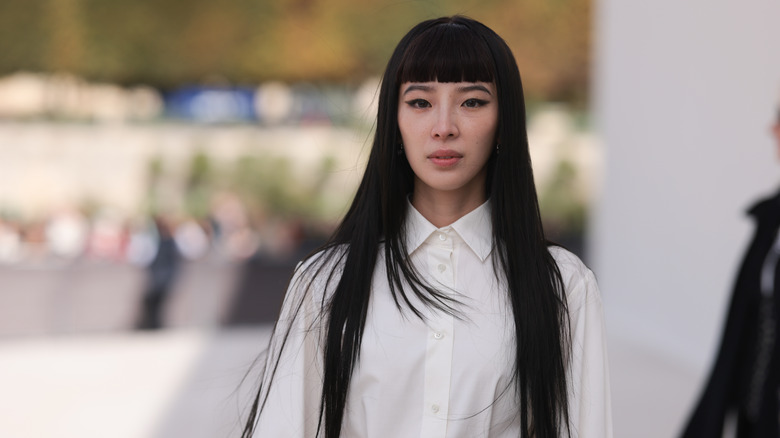Straight Hair Myths You Can Stop Believing
When it comes to hair, it seems like the grass is always greener on the other side of the fence. If you have curly hair, chances are you've probably invested serious time and effort trying to straighten it at some point in your life, and if you have straight hair, you've likely struggled at some point to get it to hold a curl for more than a few minutes at a time.
But our curly-haired friends envy those of us with ramrod-straight hair for more than just aesthetic reasons. Conventional wisdom has it that straight hair is easier to maintain, and there's definitely some truth in that — unlike curly hair, its texture and appearance don't change with the weather, so at least we know how our hair is going to behave when we wake up every morning. And according to Bustle, straight hair is the type most admired by women. However, there are a number of common misconceptions about the care and feeding of straight hair that can keep you from looking your best — here, we break down some of these.
Straight hair is inherently low maintenance
The biggest myth surrounding straight hair is that it requires zero maintenance. And while it's true that super-straight hair is simpler to style and less likely to end up tangled and unruly than a big mop of curls, it's not the case that you can just ignore it and expect it to look its best. The very features that make it so attractive are also those that make it vulnerable to damage, especially if you have super-straight, type 1A hair. (You know you have this type if your hair refuses to curl and remains completely straight even when wet, per Byrdie.)
As trichologist Anabel Kingsley explained to Byrdie, type 1A hair is finer and more fragile than other hair types, which makes it more vulnerable to breakage and split ends. It also tends to show oiliness more than other hair types for a couple of reasons. First, people with type 1A hair have a denser concentration of individual hairs on their scalps than people with other hair types, and each hair has its own oil gland. Second, the accumulation of oil is more visible on fine, straight hair and can quickly weigh it down. Thus, those with straight hair have to be extra mindful of keeping their hair clean and protecting it from damage.
A ponytail is always a safe option
No style is more closely associated with long, straight hair than the classic ponytail. It's an easy method to keep your hair out of your way and looks great on almost everyone. It's also the ultimate low-maintenance hairdo — no hot styling tools or styling products needed — so it seems to be gentle on your hair.
But appearances can be deceiving. Straight hair can be delicate and at risk of breakage, and pulling it into a tight ponytail, especially when wet, can damage it. "Hair has 50% less elasticity when wet, so imagine your hair like a rubber band," stylist Adam Maclay told Bustle. "If you stretch it and then let it dry while pulled tight ... damage is going to inevitably occur." And even if you let your hair dry naturally (as Maclay recommends) before tying it up, you can still risk damaging it if you don't use a gentle touch. "Make sure that you place minimal traction on your strands when you put it up," trichologist Anabel Kingsley advised (via Byrdie). "Ensure ponytails and braids aren't too tight."
Richer hair products add body to straight hair
If your hair is fine and straight, especially if it tends to be dry, it can be tempting to slather on the richest products you can get your hands on — anything to make limp locks look bouncy and luxurious. While the tactic sounds like it makes sense, unfortunately, it will backfire — residue from these products will weigh down your hair, making it look dull and flat (per Real Simple). And that's definitely not what you want.
Instead, you should steer toward lighter products — but stay away from those containing alcohol. "These can dry out straight, fine hair over time and cause massive damage," stylist Adam Maclay told Bustle. Also, stylist Nunzio Saviano advises taking advantage of volumizing products, which are specifically designed to maximize hair volume without weighing down your hair (per Byrdie). "Shampoos and conditioners for fine, thin hair are recommended," he said, "and a light spray gel at the root for the body."
Brush your hair right after washing to avoid tangles
One of the hallmarks of well-maintained straight hair is its glassy smoothness. So it's natural for those of us with straight hair to want to do everything possible to keep our hair smooth and orderly. And for some of us, this means taking immediate action any time — God forbid — our hair gets mussed up or threatens to tangle. For instance, after washing their hair, many immediately grab a hairbrush and go to town with it.
It's easy to see why this is tempting, but it's a bad idea. Because straight hair is more fragile than other hair types and hair, in general, is less elastic when damp, forcing a brush through it when it's wet is just asking for trouble. If tangles are a real concern after washing your hair, take your time and use a gentle touch when working on them. "Gently brush from ends to roots, working your way up in small sections to avoid overpulling your hair," stylist Adam Maclay advised Bustle.
More conditioner is always better
Straight hair can sometimes feel like thirsty hair. More prone to split ends than other hair types and a veritable magnet for static electricity in dryer months, straight hair sometimes just begs to be slathered with conditioner (per Madison Reed). And if you think your straight hair is dry and in need of some extra moisture and nourishment, you're probably right — but overwhelming fine, straight hair with heavy conditioner can weigh it down, making it lifeless and dull.
Instead, trichologist Anabel Kingsley recommends using a light conditioner containing "thickening proteins" (per Byrdie). It should be applied on the mid-lengths and ends of your hair to avoid oily scalp residue. And if your hair is seriously dry, Kingsley recommends opting for a pre-shampoo treatment to provide heavy nourishment. "This is because they don't weigh even the finest of strands down," Kingsley said. "As they are left on for the optimal length of time, with any heavy excess residue then being shampooed away, they provide type 1A hair with all the benefits, minus the heaviness that post-shampoo treatments can give."
You can make straight hair do anything you want
It's tempting to think of straight hair as a canvas for stylistic creativity — unlike some other hair types, it can be easily swept into buns and updos, braided, tied back, or cut in a variety of ways without a lot of special tools or treatment. And with hundreds of powerful tools such as flat irons, curling irons, and more at our disposal, along with salon treatments such as perms, it can feel like there's no limit to what one can do with straight hair. Finger curls? Ringlets? Big pageant hair? All of the above? Why not?
But as the old wisdom goes, just because you can do something doesn't mean you should. And as many of us with straight hair have learned from personal experience, some straight hair types simply won't hold a curl no matter what we do. According to Byrdie, this is just a natural feature of some hair types. So what should you do? Stylist Hiral Bhatia told Vogue India that the best option for your hair — not to mention your sanity and self-esteem — is to embrace the hair you were born with. Fighting it with chemical treatments will not only be time-consuming and expensive, but ultimately doomed to failure. "I've always advocated embracing your natural hair texture," Bhatia said. "I believe if you embrace anything natural, it blossoms. The more you try to oppose it, it backfires in the long run."
Wrapping your head in a towel is a good way to dry it after a shower
Even deeply rooted habits sometimes need to be seriously reexamined. Take, for instance, the classic move of wrapping your hair in a towel turban as soon as you get out of the shower. You probably learned it from your mom or older sisters, who in turn picked it up from your grandmother or other female elders. Not only does it look weirdly cool (in a retro kind of way), but it's an efficient technique to keep your hair out of the way while you attend to the rest of your beauty routine. And if it was good enough for all your female ancestors, it must be more than good enough for you.
But while your towel turban certainly won't kill you, it's not the best or gentlest way to handle just-washed hair. As stylist Carla Pisegna explained to Elle Canada, aggressively rubbing a towel into your hair right after a shampoo — as you likely do when wrapping it into a towel — can damage it. But if you absolutely can't let go of your towel turban routine, Pisegna recommends working any styling products you plan to use into your hair before wrapping it up. "When your hair becomes semi-dry, product doesn't get distributed as evenly, so apply it to your wet hair, comb it through, and then wrap it in a towel," Pisegna said.
Trimming straight hair more often will help it grow faster
Trimming your hair regularly makes tons of sense if you have short hair or a geometric cut that needs frequent trims to hold its shape. But does it actually make your hair grow faster? We've all heard this from our friends or hairdressers (who may have a vested interest in seeing us more often), and it seems so counterintuitive that it must be true. But is it really?
Well, yes and no. According to Glamour UK, frequent trims won't literally stimulate your hair to grow faster. But they will make the hair you already have stronger and less prone to breakage and split ends, thus making it easier for you to grow your hair longer without its ends breaking off. As trichologist Stephanie Sey explained to Glamour UK, split ends aren't just limited to the ends of hair — a split can grow and move up the length of a hair if not stopped. "Get your hair cut when the ends become weathered and split," she advised. "Not tackling split ends means it will travel up the hair shaft causing more damage." So while frequent trims won't actually speed up the growth of your hair, they will help you grow healthy hair more efficiently.
You can add volume to straight hair with regular use of hot tools
While naturally straight hair can be beautiful in its own right, there are times when it begs for extra volume and drama. And this is when many of us turn to our curling irons and blow dryers to add curls or a bit of a wave. These tools are intended for just that purpose, but that doesn't mean they're a fail-safe solution for everyone with straight hair. Some people with straight hair may find that their hair just can't hold a curl, and no matter how aggressively it's styled, it'll inevitably revert to its natural form in just a few hours (per Byrdie).
And even if your straight hair does hold curls well, you should still use hot tools with caution. Because straight hair tends to be fine, it is vulnerable to heat damage, and frequent, aggressive use of hot tools can end up making your hair look worse, rather than better (per Bustle). To protect your hair when styling, Garnier recommends towel-drying it before blow-drying to minimize heat exposure, using a heat protectant, and opting for lower heat settings on your tools — hotter settings don't guarantee better results.
Washing straight hair every day will keep it from looking limp
A common piece of advice for those with straight hair is to wash it every day. This is because straight hair, especially fine type 1A hair, tends to get greasy roots faster than other types (per Byrdie). And greasy buildup can be more visible on fine, straight hair. But while this might work for some people, it's not always the best solution if you have fine hair.
"Most fine hair clients feel the need to wash every day because they feel greasy after one day," stylist Jennifer Watson explained to Real Simple. "However, fine hair only needs to be shampooed two or three times per week. Over-washing can create too much oil production, which leads to flat and lifeless hair. The natural oils created with minimized shampooing add volume and manageability." If you're concerned about gunky roots on your non-washing days, dermatologist Tsippora Shainhouse recommends using dry shampoo, which will absorb oil while adding volume to your hair.
All straight hair acts the same way
Look closely, and you'll notice that not all straight hair is created equal. You might have super-straight hair that lies flat no matter what, while your straight-haired friend might notice a slight natural wave in her hair from time to time. You're not imagining things — straight hair actually falls into two main types, types 1A and 1B.
Type 1A is super-straight and superfine, and because it doesn't hold a curl, looks its best when maintained in its natural form (per Byrdie). Type 1B, on the other hand, is the type considered the Platonic ideal by many — mostly straight and well-behaved, but often with a bit of a natural wave (per Byrdie). It's also softer than type 1A hair and can curl. In reality, type 1B hair is a combination of hair types — mostly fine hairs with a smattering of coarser hairs or even wavy hairs mixed in. Both types of straight hair are prone to oily roots and breakage, so should be cleaned carefully. But while type 1A hair looks best with simple blunt cuts, 1B hair can be attractively worn in layers.
